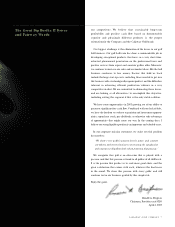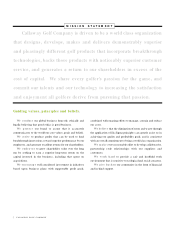Callaway 2002 Annual Report Download - page 19
Download and view the complete annual report
Please find page 19 of the 2002 Callaway annual report below. You can navigate through the pages in the report by either clicking on the pages listed below, or by using the keyword search tool below to find specific information within the annual report.
For the Ye ars En ded
De ce mber 31, Grow th/(Declin e)
(In millions, except per share data)
2002 2001 Dollars Percent
Reported net income $ 69.4 $ 58.4 $ 11.0 19%
Non-cash warranty
reserve adjustment (10.5) —
Non-cash energy
derivative charge — 14.2
Adjusted net income $ 58.9 $ 72.6 $ (13.7) (19%)
Reported basic
earnings per share $ 1.04 $ 0.84 $ 0.20 24%
Non-cash warranty
reserve adjustment (0.16) —
Non-cash energy
derivative charge — 0.20
Adjusted basic
earnings per share $ 0.88 $ 1.04 $(0.16) (15%)
Reported diluted
earnings per share $ 1.03 $ 0.82 $ 0.21 26%
Non-cash warranty
reserve adjustment (0.16) —
Non-cash energy
derivative charge — 0.20
Adjusted diluted
earnings per share $ 0.87 $ 1.02 $(0.15) (15%)
16 CALLAWAY GOLF COMPANY
excess energy supply related to an energy contract that was
terminated in November of 2001.
Interest expense remained relatively constant in 2002 at $1.7
million compared to $1.6 million in 2001.
Unrealized energy derivative losses totaled $19.9 million in 2001
as a result of the Company’s long-term energy supply contract
which was entered into during 2001. The unrealized losses were
generated by the decline in electricity rates through November,
2001. The Company did not have a similar contract in 2002. See
“Supply of Electricity and Energy Contracts” below.
During 2002, the Company recorded a provision for income
taxes of $42.2 million and realized $5.5 million in tax benefits
related to the exercise of stock options. The provision for
income tax as a percentage of income before taxes was 38% in
2002 as compared to 41% in 2001. The effective tax rate was
lower in 2002 as compared to 2001 primarily as a result of the
unrealized energy derivative losses recognized during 2001 and
the elimination of non-deductible goodwill beginning in 2002
due to the implementation of SFAS No. 142.
Net income for the year ended December 31, 2002 increased
19% to $69.4 million from $58.4 million in 2001. Earnings per
diluted share increased 26% to $1.03 in 2002 as compared to
$0.82 in 2001. Net income in 2002 was positively impacted by
the $17.0 million reduction in the warranty reserve (see above
“Change in Accounting Estimate”). Net income in 2001 was
negatively impacted by the $19.9 million energy derivative
charge (see below “Supply of Electricity and Energy
Contracts”). Excluding the $17.0 million non-cash warranty
reserve adjustment recorded in 2002 and the $19.9 million non-
cash energy derivative charge recorded in 2001, the
Company’s net income for 2002 as compared to 2001 would
have decreased 19% to $58.9 million in 2002 from $72.6 million
in 2001 and diluted earnings per share would have decreased
15% to $0.87 from $1.02.
The following summarizes what net income and earnings per
share would have been had the warranty reserve adjustment
and the energy derivative charge, adjusted for taxes, been
excluded from reported results:
The above adjusted net income and earnings per share
information has not been prepared in accordance with accounting
principles generally accepted in the United States. This
informa-
tion is being provided as additional information for interested
readers and is not intended to be in lieu of the Company’s
reported results which were prepared in accordance with
accounting principles generally accepted in the United States
and which are discussed elsewhere in this report. The
Company’s management believes that this pro forma information
is useful because it believes the adjusted results more
accurately reflect the performance of the Company’s operations.
The warranty reserve adjustment and the energy derivative
charge are both non-cash accounting adjustments. The magnitude
of the warranty reserve adjustment is unusual for the Company
and management does not believe that it is reasonably likely that
a similar adjustment of this magnitude will be made within at
least the next two fiscal years. Furthermore, the non-cash
























